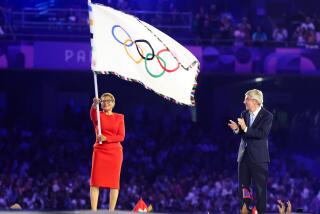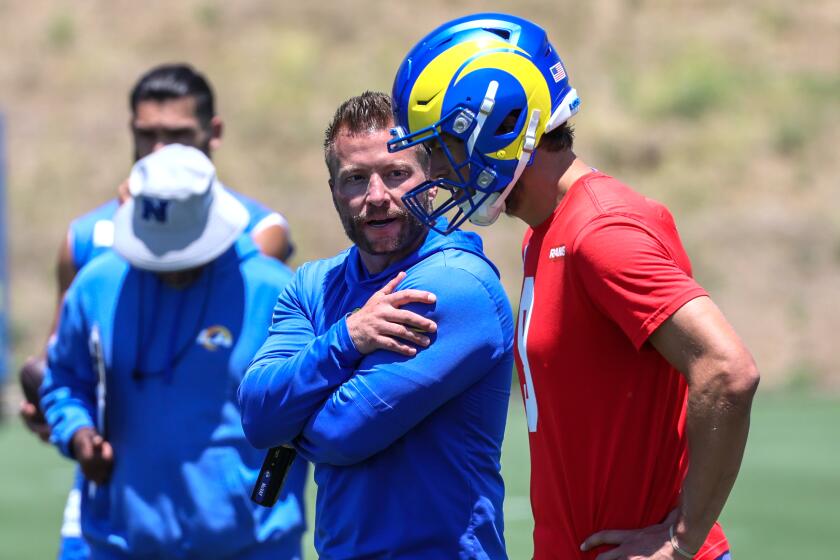NAGANO : It Will Be an Old-World, High-Tech Winter Games--They Hope
- Share via
NAGANO, Japan — When this once-sleepy temple town welcomes the world to the 1998 Winter Olympics 50 days from now, Japan’s charms and quirks will be displayed as nakedly as the scantily clad sumo wrestlers who will help open the Games.
Cheap this spectacle will not be. Japan may set an Olympic record for spending. But in return, it hopes to generate some badly needed economic and psychological cheer when the festivities begin Feb. 7.
The city and prefecture of Nagano will shell out an estimated $1.1 billion--more than twice what was spent for the 1996 Summer Games in Atlanta--on sports and housing facilities in Nagano and the five outlying towns that will host Olympic events.
But Japan is spending a stunning $12.5 billion on miles of new highways, tunnels, bridges and a new bullet train that will whisk visitors from Tokyo to Nagano in 79 minutes, down from a three-hour trip on the old trains. This spending tops even Barcelona’s $7-billion Olympic building spree for the 1992 Games.
This public works bonanza, coming amid a Japanese economic slump, has delighted many Nagano residents. But it has disgusted some beleaguered taxpayers and driven a few environmentalists to despair.
Some residents were horrified when the old train station--a charming replica of Nagano’s most famous landmark, the 16th-century Zenko-ji Temple--was demolished to build a huge, wheelchair-accessible station. Preservationists argued in vain that the old wooden building could have been incorporated into the new structure or moved aside to serve as a visitors’ center.
“I am very disappointed by the new station, but most Nagano residents are very happy,” said Takakazu Fukushima, a Buddhist priest at Zenko-ji, whose beautifully preserved medieval neighborhood is the only part of Nagano to have survived Japan’s postwar love affair with concrete, steel and prefab. “They have the new station, the improved superhighways, the wider roads. They don’t care if there is an Olympics or not!”
Meanwhile, Olympic organizers have been making Herculean
efforts to ward off every conceivable disaster, from massive traffic jams to telecommunications overload to the threatened obliteration of the food supply of an endangered species of mountain butterfly.
The warm winter blamed on El Nino has created fears that snowfall in Nagano might be lighter than usual. But organizers insist there will be plenty of snow by February, at least in the surrounding mountains where the skiing and snowboarding events are to be held.
Fears of chaos are unfounded, they say, adding that the last construction will be finished with plenty of time to spare.
Organizers are billing Nagano as the most environmentally friendly Olympics ever--although local activists say the infrastructure frenzy has trampled many fragile species.
Nevertheless, with help from volunteers, eight times more trees have been planted than were felled for Olympic construction.
“We’re not just planting trees--we’re planting species that are native to the Japan Alps,” said Yutaka Ota, spokesman for the organizing committee. “And we’re not just planting saplings--we’re planting big trees.”
Environmentalists also strongly objected to a proposed men’s downhill ski course that placed the starting gate within the grounds of a national park, prompting a bitter fight between Nagano organizers and the International Ski Federation (FIS).
After five years of bickering--with FIS President Marc Hodler at one point threatening to pull all ski events out of Nagano--a compromise course was forged earlier this month that will put the first stage of course just outside the rim of the park. Federation officials are still less than thrilled with the new layout; Hodler has deemed the course adequate, too short to be world-class.
In the scenic mountain village of Hakuba, one of the skiing venues, grasses that are the food of the endangered Gifu butterfly were transplanted to save them from the bulldozers, said Kunihiro Kobayashi, a municipal government official.
When Hakuba built a huge new ski jump for the Games--the jump that was used in a World Cup event last January--topsoil from construction sites was carefully removed and then replaced once the construction was completed, Kobayashi said. Schoolchildren have been raising native trees from acorns for replanting.
“We really tried our best to minimize the damage,” Kobayashi said.
Only people with designated parking spaces will be permitted to drive into Hakuba; others will have to ride shuttle buses. Organizers say electric cars, 60 natural-gas vehicles and 41 energy-efficient hybrid buses will be shuttling people around Nagano in an attempt to keep smog from fouling the air.
In addition, the 900,000 paper plates that athletes and spectators will use are made partly with apple pulp so they will biodegrade, and plastic plates and cutlery will be recycled into oil through a special process to be performed by Hitachi Zosen. In addition, special equipment will be on hand to turn leftover food into fertilizer.
Even the uniforms that Olympic personnel will wear can be melted down to their original nylon--zippers, Velcro, sewing thread and all--and be reborn as new nylon products. The sportswear’s manufacturer, Mizuno Corp., claims that recycling only one set of ski wear would save 2 1/2 gallons of oil and that recycling all 40,000 outfits would save enough oil to run a car around the world 45 times.
Whether anyone will turn in the sleek gray-and-black ski suits, however, is doubtful.
“They’re going to be seen as Olympic souvenirs, so very few of them will actually be recycled,” said Norihiko Iijima, who handles public relations for the Nagano Olympic Committee. “But we think it’s important to show that they could be recycled.”
The debate over the benefits of hosting the Olympics continues. A citizens’ group called People Who Don’t Want the Olympics, headed by 47-year-old weaver Masao Ezawa, has calculated that the public debt after the Olympic-related construction is about $26,153 per Nagano household. “We’re impoverishing ourselves for 20 years to pay for a two-week-long Olympiad,” Ezawa said.
Not so, says a study by the Nagano Economic Institute, which calculates that the $13.6-billion cost will stimulate $17.8 billion in economic activity.
The spending on infrastructure “should have happened long ago,” innkeeper Yuki Nagasawa said. “If it wasn’t for the Olympics, the money would have gone somewhere else. Our roads were really backward.”
Much as it did in the 1964 Tokyo Summer Olympics, which became a symbol of Japan’s postwar economic rebirth, Japan hopes to use the Nagano Olympics to showcase its latest high-tech achievements.
These include computerized traffic management systems that are supposed to keep a tsunami of cars from getting gridlocked on the narrow roads of this city of 350,000 and give official Games vehicles traffic priority, modern weather forecasting and security systems that will scan people’s irises before allowing them entry to sensitive facilities.
There will also be a time-lag adjuster that will allow conductor Seiji Ozawa to direct, via satellite, five choruses on five continents in Beethoven’s Symphony No. 9. In the past, such live satellite links would have had delays of up to four seconds. The Olympic Committee boasts that this concert will be “the greatest chorus of the century.”
The best of the new gee-whiz electronic gizmos, however, is a Dick Tracy-style telephone that looks like a wristwatch. Telecommunications giant NTT will issue the experimental wrist phones to 40 Olympic officials. If all goes well, they will hit the market two years from now.
How Big a Crowd?
It isn’t clear exactly how many people will actually come to Nagano. As of early December, 80% of the 1.28 million event tickets had been sold--100,000 of them overseas, Iijima said. Most of the popular events, such as skiing, figure skating and ice hockey, have long been sold out.
But each visitor could hold tickets to multiple events, and the new bullet train and highways now make it easier for Tokyo residents to take day trips to Nagano. With Japan’s economy at a standstill, local businesses are now worried that instead of the long-predicted hotel room crunch, there may be a hotel glut.
“The economy is bad, and though everyone says, ‘Olympics, Olympics,’ in fact, bookings are slow,” said Masuko Maruyama, who has an inn in Hakuba. Her inn offers a natural hot-springs bath, a view of the new ski jump and the mountains that rise behind, and rates that are rock-bottom by Japanese standards (about $70 per person per night, including two meals and plenty of homemade local pickles.) But it’s booked full for only two nights during the Feb. 7-22 Olympics period, the nights of the big ski jump events.
“I think a lot of people are planning to come up just for a day,” she said.
The mood in Hakuba is anything but exuberant.
“Nobody’s expecting much. It’s very quiet right now,” Maruyama said. “But when the time comes, people will rise to the occasion.
“We’re country people, after all,” she concluded, referring to the traditional local hospitality. It is considered shameful in these parts to let a guest leave unhappy. As if to prove the point, after cooking an elaborate Japanese breakfast for her guests, Maruyama insisted on driving them around town.
Hakuba, population 9,200, attracts about 3.7 million skiers and hot-springs aficionados each year, and it’s now only an hour’s bus ride from downtown Nagano, 30 minutes less than it used to be, thanks to the Olympic-inspired roadwork that includes four new tunnels cut through the mountains. But the number of skiers has fallen of late.
The town has one goal for the Olympics: to entice visitors to return. The local innkeepers’ association has decreed that there must be no rate increases during the Olympics, although a few establishments are said to have raised their prices by a third or half, Kobayashi said.
“We can’t force them, because compliance is voluntary, but on the whole, it seems to be working,” he said. “We want people to think Hakuba was great, and come back.”
A Love-Hate Relationship
Although tourist boards and local authorities are bending over backward to make a good impression on foreign visitors, Japan’s love-hate relationship with gaijin is already in evidence.
A few weeks back, some inns in Hakuba posted signs in English that read “No Foreigners Here,” said Rebecca Ann Marck, an American resident of Nagano. They were quickly taken down. Now the town hall has printed up special phrase books in six languages, including such questions as “What time does the next event begin?”
Nagano has scurried to put up signs and print up menus in English. This poses a major threat to a nation concerned with saving face, given the Japanese penchant for idiosyncratic and sometimes goofy English.
“Every piece of weird English is going to be photographed in triplicate, I’m sure,” Marck, who teaches English at Shinshu University, said with a sigh. “They don’t know it yet or they’d try harder.”
But what if the foreigners forget to use the special slippers that are supposed to be worn only in the bathroom, or use soap in the Japanese bathtubs, or commit one of the myriad other etiquette blunders that elicit hisses and giggles from their Japanese hosts?
To prevent such embarrassment, Nozawa Onsen, the tiny town to the northeast of Nagano where the biathlon will be held, has produced a special videotape about Japanese customs that is being shown on the tour buses that bring the foreigners to town.
Less humorous are the reports from Japanese merchants that shoplifting already has increased with the influx of outsiders, including foreigners. Then there are the fears of a terrorist attack, or an Atlanta-style bombing, the kind of violence that is still associated only with foreigners, despite the 1995 gas attack on the Tokyo subway system.
Zenko-ji, a national treasure that has more than 6 million visitors a year, has never closed its doors at night. But it plans to shut down at 5 p.m. during the Olympics as a security measure because of the foreign presence, Fukushima said.
Yet in order to open the temple to all comers, the temple has made itself wheelchair accessible, will allow CBS to use the temple grounds to televise the Olympics and recruited about 50 volunteers to help explain the history and spirit of Zenko-ji to foreigners in a variety of languages.
“I have no idea who’s coming, but I would love to have [foreign] people come here and hear what they have to say,” said Nagasawa, who will host the Japanese cross-country ski team in his inn in the hamlet of Uchiyama. “Isn’t it great for Nagano?”
Efron was recently on assignment in Nagano. Chiaki Kitada of The Times’ Tokyo Bureau contributed to this story.
More to Read
Go beyond the scoreboard
Get the latest on L.A.'s teams in the daily Sports Report newsletter.
You may occasionally receive promotional content from the Los Angeles Times.






